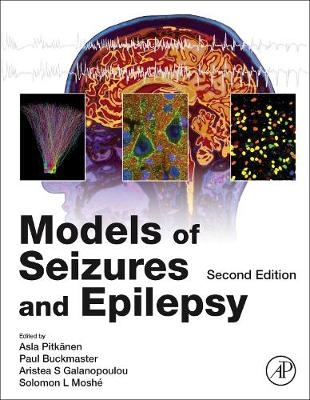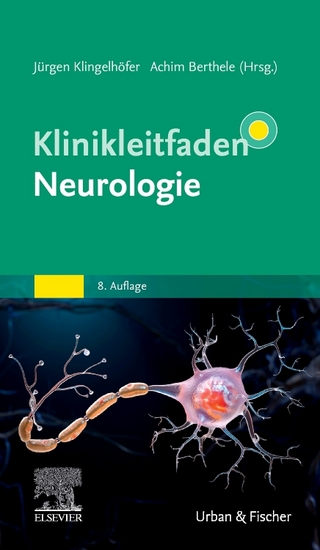
Models of Seizures and Epilepsy
Academic Press Inc (Verlag)
978-0-12-804066-9 (ISBN)
Dr. Pitkänen is currently a Professor of Neurobiology at the University of Eastern Finland in Kuopio, Finland. She has over a 30 years’ experience in working and developing animal models of acquired epilepsy and phenotyping of epilepsy models, using histologic and molecular analysis, behavioral tests, long-term video-EEG and MRI imaging. She is a leader in epilepsy research and has participated in several NINDS on Epilepsy Models Workshops and worked in several ILAE Committees related to preclinical modelling and use of models to develop better therapies for epilepsy. She has an h-index of 52 and has over 279 publications. Dr. Buckmaster is an Associate Professor of Comparative Medicine and Neurology at Stanford University School of Medicine in Stanford, California. His laboratory uses electrophysiological and anatomical techniques to evaluate neuronal circuitry of temporal lobe structures in normal and epileptic brains. He is a veterinarian with 25 years of experience investigating mechanisms of temporal lobe epilepsy using anatomical and electrophysiological techniques. He has worked with a variety of mammalian species, including primates, carnivores, and rodents. He has an h-index of 29 and has published over 74 articles. Dr. Galanopoulou is an Attending Physician at the Clinical Neuroscience Center and EEG lab at Montefiore, a Professor of Neurology and Neuroscience at Albert Einstein College of Medicine in Bronx, New York. She is also the co-chair of the AES/ILAE Translational Research Task Force of the ILAE, which works towards the optimization of the use of animal models of seizures, epilepsies, and comorbidities in epilepsy research. She is a clinical epileptologist with 15 years’ experience with epilepsy basic research using a variety of animal models and particularly models of early life seizures and epilepsies. She has an h-index of 29 and has published over 84 articles. Dr. Moshé is the is the Charles Frost Chair in Neurosurgery and Neurology and Professor of Neurology, Neuroscience, and Pediatrics at Albert Einstein College of Medicine. He is the Director of Child Neurology and Clinical Neurophysiology Dr. He has been President of the International League Against Epilepsy, American Epilepsy Society and American Clinical Neurophysiology Society (1996-1997). He is the recipient of several honors and awards, including Teacher-Investigator Development Award; Jacob Javits Neuroscience Investigator Award from NIH; Michael Prize for Achievement in Epilepsy Research; The American Epilepsy Society Research Award; Ambassador for Epilepsy Award from the International League Against Epilepsy; the Gloor Award from the American Clinical Neurophysiology Society; J.E. Purkyne Honorary Medal in Biomedical Research by the Czech Academy of Sciences; the 2008 Mentor of the Year Award from Albert Einstein College of Medicine; The 2010 Global and Awareness Award from Citizens United for Research in Epilepsy; the First Saul R. Korey Award in Translational Science and Medicine, Albert Einstein College of Medicine in 2012; elected Foreign Member of the Russian Academy of Sciences and Fellow of the American Epilepsy Society 2016. Since 1979, his research has focused on understanding the mechanisms underlying age-related differences in epilepsy in humans and in animal models.
Introduction
1. What can we model?
2. Comparative biology and species effects on expression of epilepsy
3. Strain effects on expression of seizures and epilepsy
4. Good welfare practice in modeling seizures and epilepsy
5. Ethics in the Use of Animal Models of Seizures and Epilepsy
6. Regulatory aspects of drug development
7. Use of animal models for epilepsy research and therapy development
Technical and methodological issues
8. Monitoring for Seizures in Rodents
9. Behavioral characterization and scoring of seizures in rodents
10. Seizure mimics
11. Characterization of pathology
12. Monitoring cardiorespiratory and other physiological parameters during seizures in small animals
13. Behavioral and cognitive testing procedures in animal models of epilepsy
14. In vivo Imaging in rodents
In vitro and in silico models
15. Hippocampal in silico models of seizures and epilepsy
16. Neocortical/thalamic in silico models of seizures and epilepsy
17. iPS cells, stem cells
18. Hippocampus in vitro
19. Thalamus and cortex in vitro
20. Brain slices from human resected tissues
21. Organotypic Hippocampal Slice cultures as a Model of Post-traumatic Epileptogenesis
22. The in vitro isolated guinea pig brain in the study of ictogenesis
Non-mammalian in vivo models
23. Nematode C. elegans: Genetic Dissection of Pathways Regulating Seizure and Epileptic-like Behaviors
24. Drosophila
25. Xenopus laevis
26. Zebrafish models of epilepsy and epileptic seizures
Naturally occurring seizures and epilepsies in animals
27. Veterinarian’s perspective
28. Naturally occurring epilepsy and status epilepticus in dogs
29. Naturally Occurring Temporal Lobe Epilepsy in Cats
30. Naturally occurring epilepsy and status epilepticus in Sea lions
31. Baboon Model of Genetic Generalized Epilepsy
32. Genetic Models of Reflex Epilepsy and SUDEP in Rats and Mice
33. Genetic models of absence epilepsy in rats and mice
In vivo mammalian models of induced seizures and status epilepticus
34. Electrical stimulation
35. Systemic Chemoconvulsants Producing Acute Seizures in Adult Rodents
36. Focally applied chemoconvulsants
37. Models of Chemically-Induced Acute seizures and Epilepsy: Toxic compounds and drugs of addiction
38. Pharmacologically induced animal models of absence seizures
39. Models of seizures and status epilepticus early in life
In vivo mammalian models of acquired epilepsies
40. Tetanus toxin
41. Post-SE models: Systemic kainic acid
42. Post-SE models: Focal kainic acid
43. The Pilocarpine Model of Acquired Epilepsy
44. Post-Status Epilepticus models: Electrical stimulation
45. Post-SE models: Hyperthermia
46. Epilepsy after TBI
47. Post-infectious epilepsy
48. Post-perinatal hypoxia
49. Perinatal Hypoxic-Ischemic Encephalopathy: A Model of Stroke-Induced Pediatric Epilepsy
50. Post-stroke epilepsy
51. Animal Models of Drug-Refractory Epilepsy
In vivo mammalian models of genetic epilepsies with identified gene
52. Spontaneous and Gene-Directed Epilepsy Mutations in the Mouse
53. Dravet and GEFS+ syndromes
54. Tuberous sclerosis and other toropathies
Modeling conditions that predispose to seizures or epilepsy
55. Kindling (including fast and slow kindlers)
56. Human mutations associated with brain malformations resulting in hyperexcitability in rodents
57. Dysplasias - Cortical freeze lesion
58. Dysplasia – MAM, model of developmental epilepsy
59. Dysplasias - In utero irradiation
60. Undercut cortex
61. Brain tumor–related epilepsy
62. Withdrawal seizures
63. Perimenstrual seizures and neurosteroid withdrawal
64. Metabolic disturbances: Hypo- and hyperglycemic seizures in vivo and in vitro
65. Stress
66. Blood Brain Barrier disruption
67. Experimental models of inflammation in epilepsy research
Other specific epilepsy-related syndromes
68. Infantile spasms
69. Models of epileptic encephalopathies
70. Sudep Animal Models
Animal models of other brain diseases with altered seizure susceptibility
71. Epilepsy in Models of Alzheimer’s disease
72. Animal Models of Acquired Epilepsy and Tauopathies
73. Epilepsy in other neurodegenerative disorders: Huntington’s and Parkinson’s diseases
74. Animal models of other brain diseases with altered seizure susceptibility: Autism and Fragile X Syndrome
75. Epilepsy in Models of Rett syndrome
76. Models of depression
Conclusions
77. What do models model? What needs to be modeled?
| Erscheinungsdatum | 06.07.2017 |
|---|---|
| Verlagsort | San Diego |
| Sprache | englisch |
| Maße | 216 x 276 mm |
| Gewicht | 3460 g |
| Themenwelt | Medizin / Pharmazie ► Medizinische Fachgebiete ► Neurologie |
| Naturwissenschaften ► Biologie ► Humanbiologie | |
| Naturwissenschaften ► Biologie ► Zoologie | |
| ISBN-10 | 0-12-804066-1 / 0128040661 |
| ISBN-13 | 978-0-12-804066-9 / 9780128040669 |
| Zustand | Neuware |
| Informationen gemäß Produktsicherheitsverordnung (GPSR) | |
| Haben Sie eine Frage zum Produkt? |
aus dem Bereich


